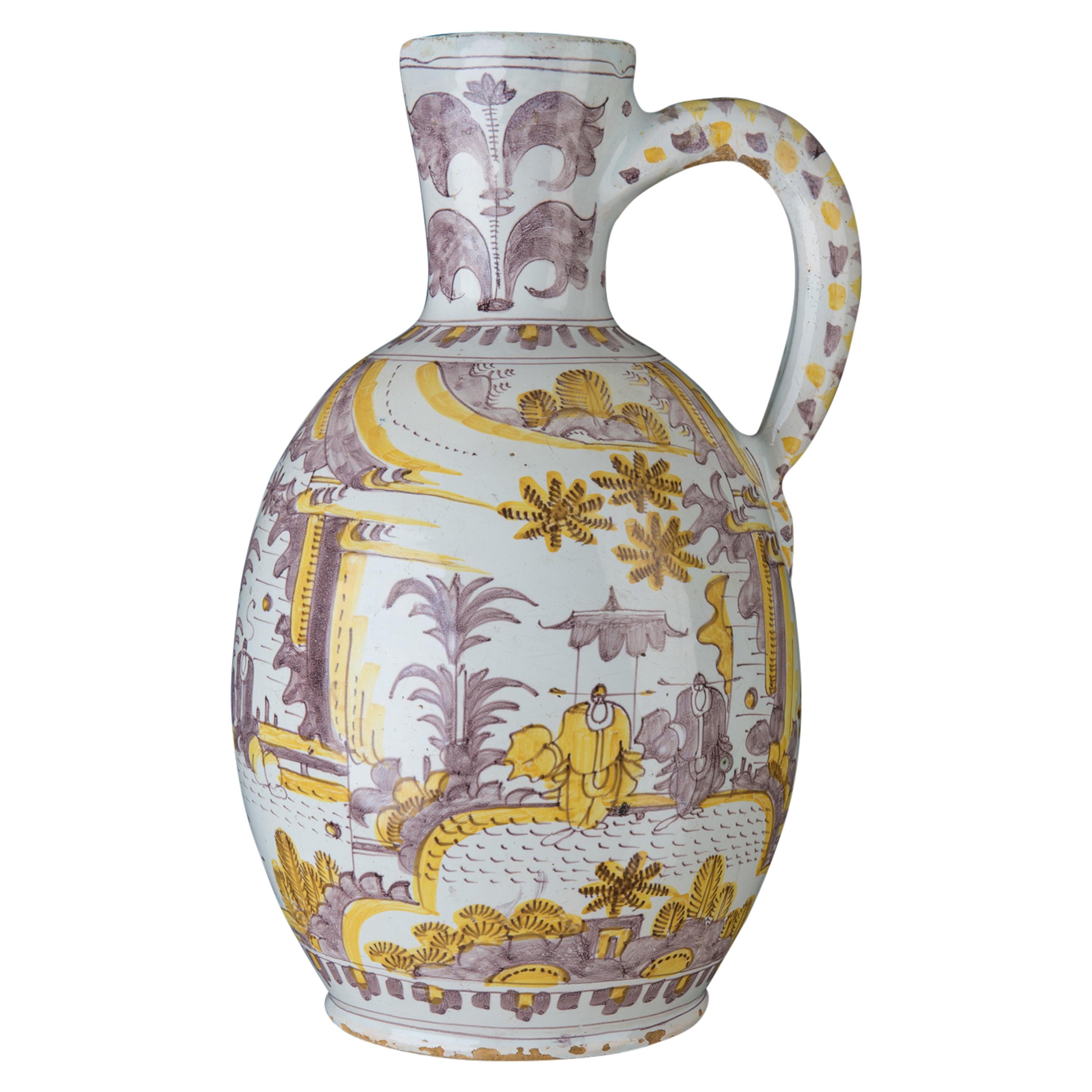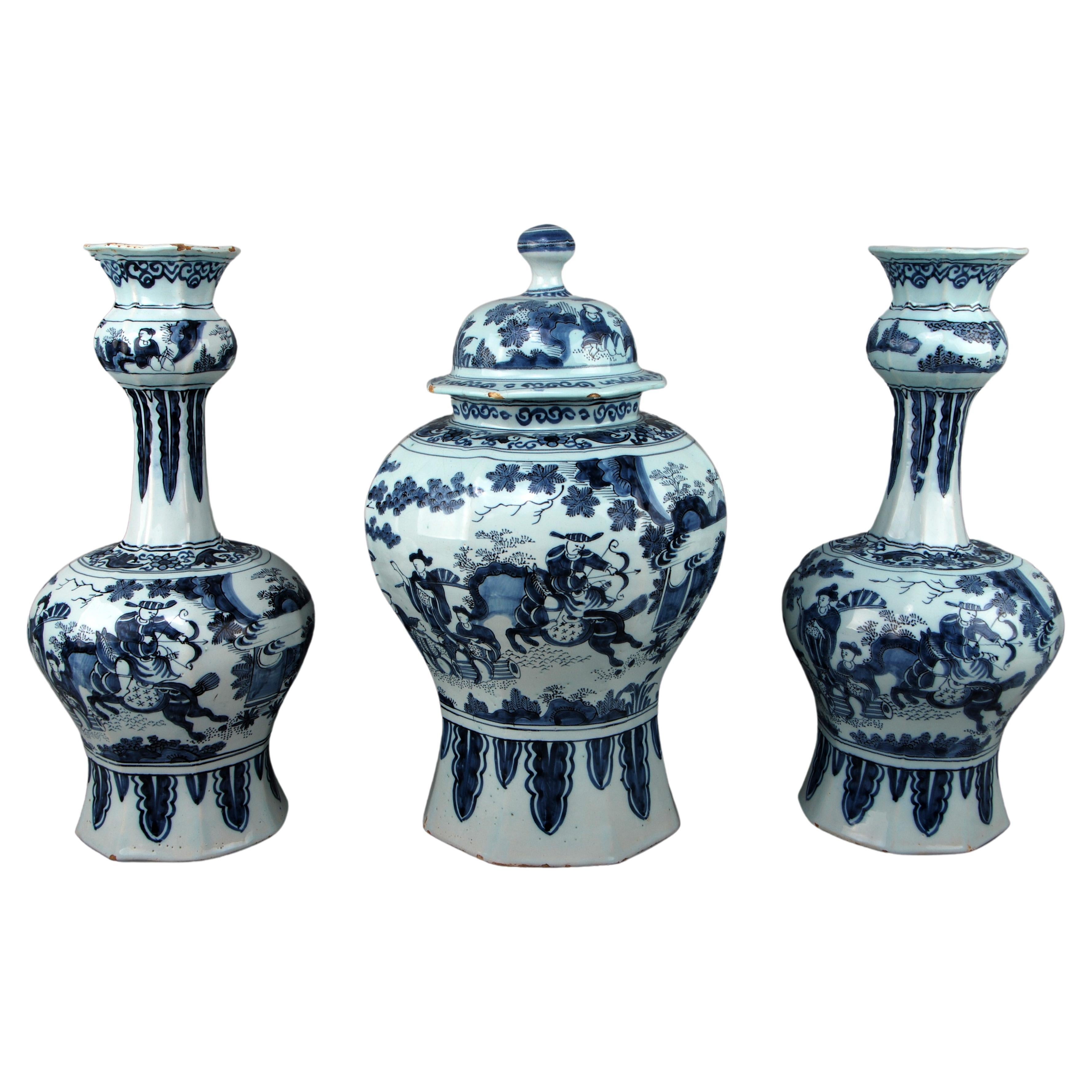Items Similar to Delft, Chinoiserie Famille Rose Garniture, 1730-1740
Video Loading
Want more images or videos?
Request additional images or videos from the seller
1 of 18
Delft, Chinoiserie Famille Rose Garniture, 1730-1740
About the Item
3 piece chinoiserie Famille rose garniture, Delft, 1730-1740
This petit feu garniture consists of a baluster vase with cover and two beaker vases. The cover has a bell-shaped knob. The baluster vase is decorated with three scroll-shaped panels, the beaker vases with two each. All panels show the same depiction of a Chinese child at play in a landscape.
On the black ground a decor of palmettes, quatrefoils, irregular shaped cartouches and foliage is applied, partly filled with floral motifs and trellis diaper work. On the shoulder of the baluster vase three reserved cartouches alternate with fields of demi-flowers on a dotted green ground. The cartouches are each filled with a single floral sprig. The same decoration with two cartouches is also painted under the upper rim of the beaker vases. The short neck of the baluster vase is decorated with floral motifs. The white foot of the vases are painted with flowers and foliage above a band of scrolls and dots. The cover is painted in the same way as the vases, the knob is executed in brown-red and blue with gilding.
Polychrome chinoiserie decoration is derived from Chinese Famille rose porcelain, which was immensely popular in the eighteenth century and came on the market from around 1720-30. Garnitures were part of the assortment. The decorations, chinoiserie landscapes and floral motifs, were frequently painted in cartouches, in many cases reserved on a coloured ground, often black. Delftware garnitures with this laborious technique were expensive and therefore rare.
The irregular shaped cartouches of this garniture are a precursor of the rococo style, which became very popular in the Dutch Republic between 1740 and 1770.
Dimensions: height of baluster vase with cover 36.5 cm / 14.37 in. height of beaker vases 26.5 cm / 10.43 in.
These vases are almost 300 years old and have the usual small glaze chips, see photos. Professional restoration to rim of one of the beaker vases.
I carefully package all items in a double-box and use first class packaging material.
- Creator:Dutch Originals (Maker)
- Dimensions:Height: 14.37 in (36.5 cm)Diameter: 7.3 in (18.55 cm)
- Sold As:Set of 3
- Style:Baroque (Of the Period)
- Materials and Techniques:
- Place of Origin:
- Period:
- Date of Manufacture:1730-1740
- Condition:Repaired: One professional restoration to rim of one of the beaker vases. Wear consistent with age and use. These vases are almost 320 years old and have the usual small glaze chips, see photos. Professional restoration to rim of one of the beaker vases.
- Seller Location:Verviers, BE
- Reference Number:1stDibs: LU1441223991602
About the Seller
4.9
Gold Seller
These expertly vetted sellers are highly rated and consistently exceed customer expectations.
Established in 2000
1stDibs seller since 2015
695 sales on 1stDibs
Typical response time: 2 hours
- ShippingRetrieving quote...Ships From: Velddriel, Netherlands
- Return PolicyA return for this item may be initiated within 3 days of delivery.
More From This SellerView All
- Delft, Purple and Yellow Chinoiserie Jug, circa 1680-1700By Dutch OriginalsLocated in Verviers, BEPurple and yellow chinoiserie jug. Delft, circa 1680 - 1700 The ovoid jug stands on a lightly spreading foot and has a tapered neck with spout. The top of the handle is pierced for a metal mount. The jug is painted in purple and yellow with a continuous chinoiserie landscape with Chinese figures. Bands with rectangular ornaments between double circles are applied on the shoulder and just above the foot. The neck is painted with a double leaf motif. The handle is decorated with stripes and dots, alternately applied in purlple and yellow. Purple or multi-coloured Delftware with chinoiserie landscapes are relatively rare, though versions in blue and purple, blue and yellow, green and purple are known, as well as three colour combinations like purple, yellow and green. A butter pot in this last colour combination was excavated from a cesspit in the grounds of the former Porcelain Bottle pottery in Delft. Multi-coloured chinoiserie decorations are painted especially on lobed dishes and also on beer mugs, covered spiced wine bowls and small plates. A purple, yellow and green painted beer mug in the Princessehof Ceramics Museum in Leeuwarden, The Netherlands, combines a chinoiserie landscape with a depiction of stadtholder prins Willem III...Category
Antique Late 17th Century Dutch Baroque Delft and Faience
MaterialsCeramic, Faience
- Delft, Blue and White Chinoiserie Altar Vase, circa 1685By Dutch OriginalsLocated in Verviers, BEBlue and white chinoiserie altar vase. Delft, circa 1685 The ovoid altar vase stands on a high-waisted foot. The flaring cylindrical neck ends in an outward sloping mouth rim. The two blue coloured lion-shaped handles have suspending rings in their jaws. The body is painted with a continuous oriental landscape with banana and pine trees, Chinese figures and houses, while the neck is painted with three bands of different ornaments. The mouth rim is decorated with rectangular ornaments, the foot with leaves under a band around the ankle. Altar vases are also called vases à chimères. The oldest faience examples were made in the sixteen-twenties in Nevers, France and are attributed to the Conrade potters family, who originated from Italy. The shape is based on metal vases used during the services in Catholic churches. Therefore it is no wonder that many altar vases are painted with the Christogram IHS. Altar vases were made in Delft from about 1675 onwards and production continued well into the eighteenth century. Marked examples are known from multiple manufacturers, such as The Greek A and The Moor’s Head potteries (Aronson 2011, pp. 14-15). A pair of eighteenth century vases was made between 1700 and 1716 at The Three Porcelain Ash Barrells pottery. They are marked with PK for the owner Pieter Kam or, after 1705, by his widow (Blazy & Boyazoglu 1983, p. 110). The pair is painted with a dense parsley decor. A miniature example was excavated from a cesspit in the grounds of the former Porcelain Bottle pottery in Delft. At the same location a larger fragment was also found, decorated with a triple-tulip design in blue and yellow (Eliëns, Schledorn, Van Aken-Fehmers, pp. 31 , 36, 45). Three altar vases with similar tulip and flower decoration in blue and yellow are in the collection of the Dutch Open Air Museum in Arnhem and can also be attributed to the Porcelain Bottle pottery (Klein, p. 152). Official Catholic services were not allowed in the seventeenth century in the Dutch republic, however Catholic conventicles were tolerated. At first sight it might be surprising that a Catholic object...Category
Antique Late 17th Century Dutch Baroque Delft and Faience
MaterialsCeramic, Faience
- Delft, Blue and White floral Chinoiserie Jar, 1650-1680By Dutch OriginalsLocated in Verviers, BEThe ovoid jar stands on a slightly spreading foot, has a short upright neck, and is painted in blue with a floral decor. Three large cartouches containing flower bouquets have been a...Category
Antique 17th Century Dutch Baroque Delft and Faience
MaterialsCeramic, Faience
- Polychrome Chinoiserie Bowl, Delft, 1710-1730By DelftLocated in Verviers, BEPolychrome chinoiserie bowl. Delft, 1710-1730 This polychrome bowl stands on a high foot and has three extra feet. The two angular handles are ver...Category
Antique Early 18th Century Dutch Baroque Delft and Faience
MaterialsFaience, Ceramic
- Delft, Large Blue and White Chinoiserie Dish, 1670By Dutch OriginalsLocated in Verviers, BEBlue and white chinoiserie dish. Delft, circa 1670 Blue and white dish with a wide-spreading flange, the center painted with two conversin...Category
Antique Late 17th Century Dutch Baroque Delft and Faience
MaterialsCeramic, Faience
- Dutch Delft Blue and White ceramic Chinoiserie Plaque. 1740-1760By DelftLocated in Verviers, BEBlue and white chinoiserie plaque. Delft, 1740-1760. The oval blue and white plaque has a molded rim with four raised, oval cartouches. At the to...Category
Antique Mid-18th Century Dutch Baroque Delft and Faience
MaterialsCeramic, Faience
You May Also Like
- Important 17th Century Delft Chinoiserie Three Piece GarnitureLocated in AMSTERDAM, NHAn important 17th century Delft chinoiserie three-piece garniture The Netherlands, Delft. Last quarter of the 17th century An important and rare Delft garniture of three pieces. The shape and decoration are inspired on the Chinese Transitional porcelain...Category
Antique Late 17th Century Dutch Chinoiserie Delft and Faience
MaterialsFaience, Ceramic
- Royal Delft Garniture of 3 Vases Chinoiserie Beaker and Baluster Vases a pairBy Delft, AK Dutch Delftware, Royal DelftLocated in Wommelgem, VANA 3 pieces garniture of Dutch Delftware Royal Delft vases - Urns. Tall decorative covered baluster vases on an octagonal foot with 2 matching beaker vases The vases are hand crafted ...Category
20th Century Dutch Baroque Revival Delft and Faience
MaterialsEarthenware, Delft
- Delft Garniture Set, 18th CenturyLocated in Dallas, TXHand-painted set of blue and white delft porcelain. Three covered vases and two trumpet vases. The lids depict perched birds. The vases ...Category
Antique 18th Century and Earlier Dutch Garniture
MaterialsPorcelain
- Polychrome Chinoiserie Lobed Dish Delft, 1680-1690By Dutch OriginalsLocated in ROSSUM, GEPolychrome chinoiserie lobed dish. Delft, 1680-1690 The lobed dish is composed of nine wide lobes around a nine-fold centre and is painted with a chinoiserie decor in purple, yellow and green. Two Chinese figures in an eastern landscape are depicted in the centre, one of them carries a banner. The landscape is framed within lines and a white band. The border is decorated with a continuous landscape with two reclining and two standing Chinese figures. A lobed dish of the same shape and design in purple, blue and green is in the collection of the Victoria and Albert Museum in London. The Museum of Fine Arts in Boston, Massachusetts holds a variant in blue and yellow. In the same museum are three lobed dishes, each with twenty-seven double lobes with chinoiserie landscapes in the same colour scheme of purple, yellow and green. In the second half of the seventeenth century many lobed dishes were painted with Chinese motifs, mostly landscapes with Chinese figures. The vast majority are in blue. Two- or multi-coloured chinoiserie decorations were very fashionable during a short period of time, predominantly in the 1680s. In addition to lobed dishes, they also appear on wine jugs, beer mugs, butter pots, covered spiced-wine bowls and dishes. Some of this Delftware is still wrongly attributed to a factory in the German town of Frankfurt, and sometimes it is even considered to be English. An excavated chinoiserie butter pot in purple, green and yellow, found in a cesspit in the grounds of the Porcelain Bottle factory, proves otherwise. A beer mug with the portrait of the Dutch prince Willem III...Category
Antique 17th Century Dutch Baroque Delft and Faience
MaterialsCeramic, Faience
- Blue and White Delft Handled Chinoiserie VaseBy DelftLocated in New York, NYBlue and white Delft handled chinoiserie vase. Antique Dutch porcelain vase with rich blue flowers and chinoiserie fencing in a lustrous glaze; with scro...Category
Antique Late 18th Century Dutch Chinoiserie Delft and Faience
MaterialsCeramic
- Large Dutch Delft Garniture Five Piece Polychrome Made Circa 1880 NetherlandsLocated in Katonah, NYThis charming Dutch Delft garniture comprises the traditional five pieces: two beaker vases and three baluster-form jars with their covers. It is in excellent condition. We see a rom...Category
Antique Late 19th Century Dutch Romantic Delft and Faience
MaterialsDelft
Recently Viewed
View AllMore Ways To Browse
Antique Rose Glass
Dutch Kitchen
Black Rose Antique
Dutch Decorated
Dutch China
Dutch Baroque
Blue Delft Holland
Delft Blue Holland
Dutch Delft Blue
Dutch Baroque Furniture
Delft Flowers
Silver And Blue Small Box
Dutch Delft Blue And White
Chinoiserie Landscape
Dutch Blue Ceramics
Rose Shaped Flower
Dutch Decor
Green Faience





